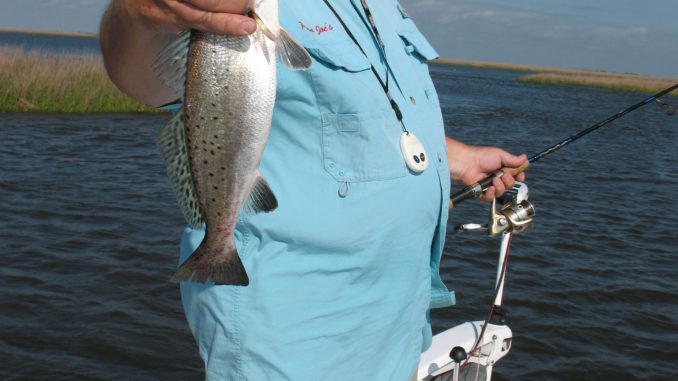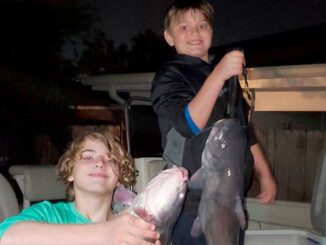
Here are some tips on where to go in response to the Bonnet Carre Spillway opening
Unless you are strictly a freshwater angler, the opening of the Bonnet Carre’ Spillway has definitely altered your fishing plans for the summer. On May 9, the Corps of Engineers began opening the bays of the spillway to divert some of the rising river water into Lake Pontchartrain, and from there into the Gulf. Eventually they would open 330 of the projects 350 bays, sending enough fresh water into the lake to make it a virtual extension of the Mississippi River.
The opening was a painful but necessary step to reduce the height of the swollen river at New Orleans and prevent it from overtopping the levees or breeching them altogether. Thankfully, the project worked like it was designed to, and with the additional opening of the Morganza Spillway above Baton Rouge, the possibility of a major flood event at either metropolis was averted.
Fishing, however, was adversely affected, and will be for quite some time. How far will the fresh, muddy river water reach? Will Lake Pontchartrain be fishable at all this summer? This fall? What about Lake Borgne? What about the east and west sides of the river and other areas?
For answers to these and other questions, Louisiana Sportsman interviewed coastal scientist and acting executive director of the Lake Pontchartrain Basin Foundation, John Lopez (www.saveourlake.org).
Lopez says they have closely monitored the transition of the lake from its usual br ackish water into basically an arm of the Mississippi River.
“The salinity levels fell quickly once the sheer volume of the water pouring through the spillway gates diluted and displaced the normal lake water, until the level today is virtually nil,” he said. “The fresh, muddy river water has displaced the normally brackish lake water nearly 100 percent.
“There could be a pocket here or there with some slight salinity left. The northwest corner had a small section for a while, but the sheer volume of fresh water flowing into the lake will reduce that to the point that Lake Pontchartrain will be near 100-percent fresh.”
Fish kills
Lopez says some fish kills have already been reported, but they were small in number and unusual.
“Normally you see a lot of small fish affected in a fish kill, usually by the depletion of oxygen in the water,” he said. “The ones we saw so far were larger fish, and not many of them, so we suspect some other cause of death. But fish kills can be expected over the summer in Lake Pontchartrain as the turbidity decreases, the nutrients brought into the lake settle and the heat turns on, resulting in toxic algae blooms. Those depleted oxygen zones become dead zones, and fish kills are possible.
“However, the recreational fish like trout and redfish will not be affected because they’re already gone from the lake, pushed out by the fresh water. What will be affected is the freshwater fish that flushed in through the Spillway — mostly carp and catfish.”
Lopez said the algae blooms showed up in the lake by July 12 when they last opened the spillway in 2008.
“But they opened the spillway a month earlier that year,” he said. “I suspect the blooms will show up about the same time this year due to the heat, and I also think they’ll persist longer this time because it’ll take longer to circulate those nutrients out of the lake, due to the closure of the Intracoastal Canal at Seabrook and the MRGO, leaving only the Rigolets and Chef as conduits in and out.”
Lopez said we can expect it to take 6 to 8 months or even longer to get the lake back to normal salinity levels.
“The lake will heal itself over time. Nature is resilient, but this amount of fresh water brought in a load of nutrients that will take time to flush out,” he said.
Lake Borgne impact
Surprisingly, Lopez doesn’t think Lake Borgne will suffer the same fate as Lake Pontchartrain.
“Despite the closure of the MRGO at Hopedale, which normally would have allowed water to flow much more freely in and out of Lake Borgne from the south side, it still has wide egress through the Mississippi Sound on the north side,” he said. “I think Lake Borgne will basically become what Lake Pontchartrain was; that is, fresh on the west end like Lake Maurepas, but brackish on the east side.
“I think the salinity levels will be essentially what those of Lake Pontchartrain usually are, and though they may be diluted somewhat, there could be enough circulation to keep the lake productive and fishable. The possibility is that Lake Borgne could get all the trout and redfish action that Lake Pontchartrian usually has at this time of year, so it could be very productive.”
Echoing that sentiment, Frank Campo Jr., over at Campo’s Marina in Shell Beach (504-239-5165), said previous openings of the spillway didn’t really hurt them.
“It could be different this time because the fresh water can’t really escape as fast as it used to down the MRGO,” he said. “Worst-case scenario, we could be inundated by muddy river water and socked in for weeks.
“It would ruin Lake Borgne temporarily and make it impossible for us to keep bait alive.
“What we hope is that any fresh water that flows our way will circulate right back out through Bayou LaLoutre on either side and through Mississippi Sound.
“Some years ago when they opened the Spillway, the trout stacked up so thick on the east side of Lake Borgne that you’d kill fish with your prop when you passed by.
“The key will be to see what the wind and current do with all that fresh water coming through the passes. I think it’ll depend on whether we get good water coming in through the sound from the Gulf, and that’ll depend on winds and tides.”
Editor’s note: This article is part of the Spillway effect feature in the July issue of Louisiana Sportsman. Digital editions can be downloaded right to your computer or smartphone.
Be sure to subscribe to ensure you don’t miss a single information-packed issue of Louisiana Sportsman.
